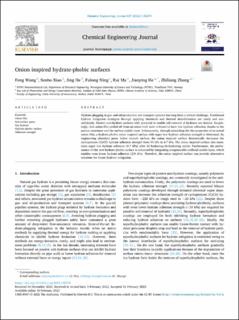| dc.contributor.author | Wang, Feng | |
| dc.contributor.author | Xiao, Senbo | |
| dc.contributor.author | He, Jing | |
| dc.contributor.author | Ning, Fulong | |
| dc.contributor.author | Ma, Rui | |
| dc.contributor.author | He, Jianying | |
| dc.contributor.author | Zhang, Zhiliang | |
| dc.date.accessioned | 2022-04-26T08:05:00Z | |
| dc.date.available | 2022-04-26T08:05:00Z | |
| dc.date.created | 2022-02-13T21:23:29Z | |
| dc.date.issued | 2022 | |
| dc.identifier.issn | 1385-8947 | |
| dc.identifier.uri | https://hdl.handle.net/11250/2992708 | |
| dc.description.abstract | Hydrate plugging in gas- and oil-production and transport systems has long been a critical challenge. Traditional hydrate mitigation strategies through applying chemicals and thermal destabilization are costly and eco-unfriendly. Passive anti-hydrate surfaces with potential to enable self-removal of hydrates are desired. Surprisingly, thin onion film peeled off from an onion bulb scale is found to have low hydrate adhesion, thanks to the porous structures and the surface cuticle layer. Subsequently, through mimicking the bio-properties of an actual onion film, a hydrate-phobic onion inspired surface with super low hydrate adhesion strength is fabricated. By engineering abundant pores below smooth surface, the onion inspired surface dramatically decreases the cyclopentane (CyC5) hydrate adhesion strength from 95 kPa to 4.7 kPa. The onion inspired surface also maintains super low hydrate adhesion (8.7 kPa) after 20 hydrating/dehydrating cycles. Furthermore, the performance of this new hydrate-phobic surface is enhanced by integrating a regenerable artificial cuticle layer, which enables even lower hydrate adhesion (2.9 kPa). Therefore, the onion inspired surface can provide alternative solutions for future hydrate mitigation. | en_US |
| dc.language.iso | eng | en_US |
| dc.publisher | Elsevier | en_US |
| dc.rights | Navngivelse 4.0 Internasjonal | * |
| dc.rights.uri | http://creativecommons.org/licenses/by/4.0/deed.no | * |
| dc.title | Onion inspired hydrate-phobic surfaces | en_US |
| dc.type | Peer reviewed | en_US |
| dc.type | Journal article | en_US |
| dc.description.version | publishedVersion | en_US |
| dc.source.volume | 437 | en_US |
| dc.source.journal | Chemical Engineering Journal | en_US |
| dc.identifier.doi | 10.1016/j.cej.2022.135274 | |
| dc.identifier.cristin | 2001081 | |
| dc.relation.project | Norges forskningsråd: 295864 | en_US |
| dc.relation.project | Norges forskningsråd: 302348 | en_US |
| dc.relation.project | Norges forskningsråd: 250990 | en_US |
| cristin.ispublished | true | |
| cristin.fulltext | postprint | |
| cristin.fulltext | original | |
| cristin.qualitycode | 2 | |

